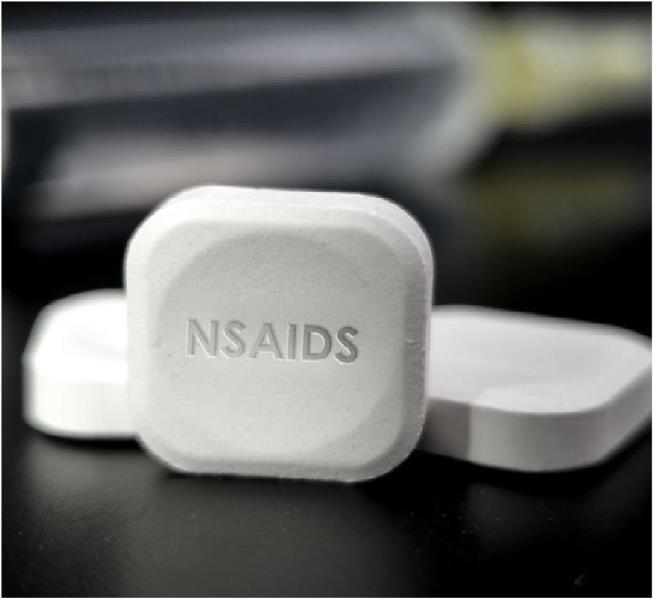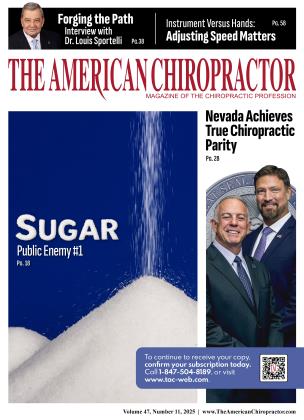
“Multiple processes in the inflammation pathways must happen to resolve inflammation, and when they don’t happen, it becomes difficult for the body to recover from out-of-control inflammation.”
MOST OF YOUR PATIENTS INTUITIVELY KNOW that nonsteroidal anti-inflammatory drugs (NSAIDs) such as aspirin and ibuprofen are counterproductive for bone and tissue healing when taken long term,1 but are they aware that they work against them from the beginning, even when taken short term? Are you prepared to give them reasonable protocols that allow for alternative pathways?
It is well established that taking NSAIDs long term is detrimental to the kidneys, circulatory system, gut, and structure of bone, connective tissue, and muscle.2,3,4,5,6 For instance, NSAIDs interfere with the prostaglandin pathway. Granted, some of those prostaglandins (especially PGE2) are inflammatory and cause pain, but there are beneficial prostaglandins that make up the mucus lining of our stomach and intestines; continued use wears away the protective lining and results in ulcer formation. The intestines are not the only organ that suffers from these OTC anti-inflammatory substances, as mentioned earlier.
What happens when they are taken short term? Multiple processes in the inflammation pathways must happen to resolve inflammation, and when they don’t happen, it becomes difficult for the body to recover from out-of-control infl aimnation. Patients need to understand that certain processes are necessary for the early healing phase, and that NSAIDs can delay healing by impeding the recruitment of immune cells and growth factors necessary for tissue regeneration. NSAIDs can block pain that arises from a subluxation, when an adjustment may be what is needed to remove the cause of the pain.
NSAIDs can inhibit repair pathways. One example is a neutrophil process that causes inflammation while helping resolve it, but it is blocked by NSAIDs.7 Another example is resolvins that are made as by-products from fish oil. Resolvins help “resolve” pain and inflammation, but NSAIDs interfere with the production of resolvins and the resolution of pain and infl aimnation.8
Once the patient is educated on how NSAIDs are actually setting them up for chronic pain and inflammation, are they aware of alternative pathways that allow them to avoid taking NSAIDs? One of the best known nutrients for support is fish oil that is high in EPA and DHA, which can be efficacious support. Be sure to get a pharmaceutical grade that is molecularly distilled so that you don’t wind up ingesting more toxins than the fish oil will clear. If you want to read about how fish oil went up against NSAIDs in clinical trials, check out Maroon and Bost in the references below.9
Other nutrient support that is efficacious but not deleterious to normal inflammatory pathways (natural substances can modulate but do not totally block pathways like drugs) includes ligament connective tissue support, such as magnesium and manganese. Herbs like feverfew, white willow bark, valerian, passion flower, skullcap, and curcumin make excellent adjunctive support.
Even though it sounds like a list of ingredients for a salad, spices like ginger, oregano, thyme, and basil have extremely interesting properties when it comes to adding them to a protocol. Oxidative stress activates inflammation, and antioxidant action indirectly reduces signaling involved in the process, so any nutrient with antioxidant properties (like these spices) offers inflammation support.
Cartilage support, along with N-acetyl glucosamine and proteolytic enzymes that mop up proteinaceous debris like bromelain can also be very helpful. Additionally, topicals with ingredients like proteolytic enzymes, arnica montana, aloe vera, and peppermint, for instance, can also add to beneficial results.
Magnesium limits NF-KB signaling, cytokine production (IL-6, TNF-a, IL-1), and oxidative stress by way of NMD A receptor activation, resulting in an elevated level of support for inflammatory scenarios. In fact, a meta-analysis of over 96 entries demonstrated that magnesium had a beneficial effect on lowering C-reactive protein.10 Magnesium can also relieve oxidative stress that is known for escalating inflammation beyond its normal cycle.11
Manganese is often sequestered by calprotectin during inflammation (calprotectin comprises the majority of the soluble protein content of the cytosol of a neutrophil, and remember, the neutrophil process is necessary for inflammation resolution).12 Manganese is good for supporting healthy ligaments and connective tissue and for contributing to the maintenance of adjustments.
Feverfew contains parthenolide (and other constituents like flavonoid glycosides), which has an effect on NF-KB activation, the cytokines IL-6, TNF-a, and gene expression. Feverfew is purported to have “multiple pharmacologic properties” and be a “multipurpose medicinal agent.”13 Amongst its many properties, feverfew is helpful support during the inflammatory process.
White willow bark is well known for containing salicylates, but it also contains compounds that include phenols, flavanols, and procyanidins and has excellent antioxidant activity, which is helpful in resolving the inflammatory process. In fact, white willow bark exhibits such strong antioxidant potential that it was noted to be stronger than vitamin C used as a standard.14 The same authors also noted that “specialized secondary plant metabolites (of white willow bark) are known to exhibit a wide range of biological activities.”
“Curcumin is extracted from turmeric and is probably the widest known nutrient for inflammation support”
Valerian, passion flower, and skullcap have always had a reputation as calming herbs for the central nervous system. They support times of inflammation and stress, especially anxiety-induced inflammatory responses. The main mechanism is believed to be indirectly through the influence on the hypothalamic pituitary adrenal (HPA) axis, GABA (neuroinhibit ory), and cortisol.
Curcumin is extracted from turmeric and is probably the widest known nutrient for inflammation support. An umbrella review covering 25 meta-analyses published as recently as a few months ago (June 2025) concluded that “available evidence suggests that curcumin is a safe medicinal agent that improves multiple clinical outcomes,” including pain and inflammatory markers.15 Mechanisms of action include influence on NF-kB, cytokines such as TNF-a, IL-6, IL-IB, NLRP3 inflammasome, and Nrf2, which is actually a transcription factor that can induce antioxidant defense genes.
Ginger, oregano, thyme, and basil all have antioxidant activity and are very high in polyphenols. They are all spices, and readily abundant, so whenever having salads and other culinary dishes, add them for flavor and inflammation support.
In conclusion, once inflammation starts, natural processes exist that actually help inflammation resolve (for example, neutrophil activity), and they are blocked by NSAIDs. Additionally, NSAIDs block several healing pathways that can help resolve inflammation and repair connective tissue. Education can help the patient make decisions about steps that will create an enviromnent that will help keep inflammation from arising and contribute to beneficial and healthful support once the inflammatory process has started.

Dr. Lynn Toohey organizes seminars, acts as a nutritional consultant to Nutri-West (www.NutriWest.com) and authored the Functional Health Evaluation program that analyzes blood tests and DNA raw data (www.FHEcloud.com). Dr. Toohey can be reached at [email protected] with any questions.
References
1. Hertel J. The role of nonsteroidal anti-inflammatory drugs in the treatment of acute soft tissue injuries. JAM Train. 1997 Oct;32(4):3508. PMID: 16558472; PMCID: PMC1320354.
2. Wongrakpanich S, Wongrakpanich A, Melhado K, Rangaswami J. A comprehensive review of non-steroidal anti-inflammatory drug use in the elderly. Aging Dis. 2018 Feb 1;9(1): 143-150. doi: 10.14336/ AD.2017.0306. PMID: 29392089; PMCID: PMC5772852.
3. Varga Z, Sabzwari SRA, Vargova V. Cardiovascular risk of nonsteroidal anti-inflammatory drugs: an under-recognized public health issue. Cureus. 2017 Apr 8;9(4):ell44. doi: 10.7759/cureus.ll44. PMID: 28491485; PMCID: PMC5422108.
4. Gerriets V, Anderson J, Patel P, Nappe TM. Acetaminophen. 2024 Jan 11. In: StatPearls [Internet], Treasure Island (FL): StatPearls Publishing; 2025 Jan-. PMID: 29493991.
5. Su B, O'Connor JP. NS AID therapy effects on healing of bone, tendon, and the enthesis. J ApplPhysiol (1985). 2013 Sep;115(6):8929. doi: 10.1152/japplphysiol.00053.2013. Epub 2013 Jul 18. PMID: 23869068; PMCID: PMC3764618.
6. Hamilton A. Andrew Hamilton BSc Hons, MRSC, ACSM; author Sports Bulletin. 2021. 11(6).
7. Parisien M, Lima LV, Dagostino C, El-Hachem N, Drury GE, Grant AV, Huising J, Verma V, Meloto CB, Silva JR, Dutra GGS, Markova T, Dang H, Tessier PA, Slade GD, Nackley AG, Ghasemlou N, Mogil JS, Allegri M, Diatchenko L. Acute inflammatory response via neutrophil activation protects against the development of chronic pain. Sci Transi Med. 2022 May ll;14(644):eabj9954. doi: 10.1126/ scitranslmed.abj9954. Epub 2022 May 11. PMID: 35544595; PMCID: PMC10317000.
8. Serhan CN, Levy BD. Resolvins in inflammation: emergence of the pro-resolving superfamily of mediators. J Clin Invest. 2018 Jul 2;128(7):2657-2669. doi: 10.1172/JCI97943. Epub 2018 May 14. PMID: 29757195; PMCID: PMC6025982.
9. Maroon JC, Bost JW. Omega-3 fatty acids (fish oil) as an anti-inflammatory: an alternative to nonsteroidal anti-inflammatory drugs for discogenic pain. Surg Neurol. 2006 Apr;65(4):326-31. doi: 10.1016/j. surneu.2005.10.023. PMID: 16531187.
10. Mazidi M, Rezaie P, Banach M. Effect of magnesium supplements on serum C-reactive protein: a systematic review and meta-analysis. Arch Med Sci. 2018 Jun;14(4):707-716. doi: 10.5114/ aoms.2018.75719. Epub 2018 May 11. PMID: 30002686; PMCID: PMC6040119.
11. Cazzola R, Della Porta M, Piuri G, Maier JA. Magnesium: a defense line to mitigate inflammation and oxidative stress in adipose tissue. Antioxidants (Basel). 2024 Jul 24;13(8):893. doi: 10.3390/antioxl3080893. PMID: 39199139; PMCID: PMC11351329.
12. Marshall, WM et al. Clinical biochemistry: metabolic and clinical aspects (3 ed.). Elsevier Health Sciences, 2014.
13. Pareek A, Suthar M, Rathore GS, Bansal V. Feverfew (Tanacetum parthenium L): A systematic review. Pharmacogn Rev. 2011 Jan;5(9): 103-10. doi: 10.4103/0973-7847.79105. PMID: 22096324; PMCID: PMC3210009.
14. Piatczak E, Dybowska M, Pluciennik E, Kosla K, Kolniak-Ostek J, Kalinowska-Lis U. Identification and accumulation of phenolic compounds in the leaves and bark of Salix alba (L.) and their biological potential. Biomolecules. 2020 Sep 29;10(10):1391. doi: 10.3390/ bioml0101391. PMID: 33003576; PMCID: PMC7600001.
15. Xu Q, Lian H, Zhou R, Gu Z, Wu J, Wu Y, Li Z. Curcumin and multiple health outcomes: critical umbrella review of intervention meta-analyses. Front Pharmacol. 2025 Jun 5;16:1601204. doi: 10.3389/ fphar.2025.1601204. PMID: 40538540; PMCID: PMC12176752.
 View Full Issue
View Full Issue






